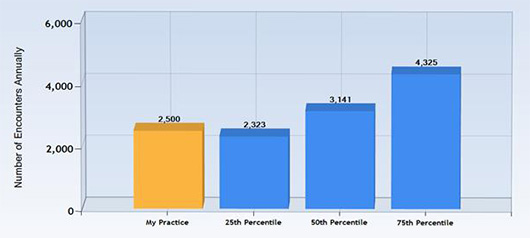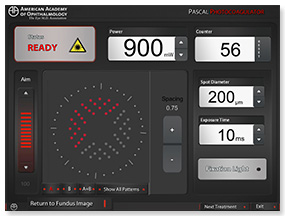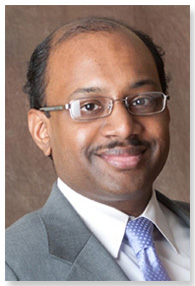What's Happening
2014 Benchmarking Survey Results
Earlier this year, the Academy and AAOE launched AcadeMetrics to provide national benchmarks to aid members in decision making for their practices. AcadeMetrics comprises 1) a financial benchmarking survey, and 2) a salary survey. Here are highlights of the financial benchmarking survey.
Financial trends. Compared with the data from 2011—the last time the Academy and AAOE conducted a benchmarking survey—some noteworthy trends became evident.
- The median percent of revenues spent on practice overhead has risen by 3 percent for comprehensive ophthalmology practices, and by about 6 percent for retina and multisubspecialty clinics. This is due to reduced or stable reimbursements and higher costs, including those for computer systems and compliance with government regulations.
- Retina-only practices also saw a 20 percent uptick in the number of full-time equivalent (FTE) staff members employed per FTE doctor. This coincided with a decrease in revenues per FTE staff member—practices have added employee hours without a corresponding increase in revenue.
- On the bright side, new software systems and the ability to verify insurance benefits online prior to patient appointments have made billing departments more efficient. The median revenues per FTE billing person in comprehensive practices rose about 15 percent between 2011 and 2013, while the median accounts receivable days outstanding dropped by 10 percent.
Other benchmarks. The benchmarking survey includes other helpful measures, including the following:
- The number of patient encounters that a typical full-time front desk person processes per year, the number of patient visits an ophthalmologist usually performs, and the percentage of revenues spent on front desk personnel, technicians, and billing staff are useful in gauging staffing decisions.
- For practices with optical shops, the median revenues generated per full-time optician and the percent of revenues spent on the cost of frames and lenses help determine cost-efficiency.
- Revenue production, the number of patient encounters, and the average revenue per encounter for optometrists employed in a practice can help assess the value of those providers.
How to see more detailed results. Practices that submitted their financial data earlier this year can log in to www.aao.org/benchmarking to compare figures. Reports can be created that allow comparison by practice region and size. Similarly, participate in the salary survey to access custom reports.
Timeline for participation. The financial benchmarking survey will be open for submissions for six weeks in early 2015. The salary survey is ongoing and is available year round. The results of both surveys are available at no cost—but only to Academy and AAOE members who submit their data.
 |
|
COMPARE YOUR PRACTICE. This chart shows encounters per FTE optometrist.
|
Take Notice
FAAO Annual Report
The Foundation of the American Academy of Ophthalmology (FAAO) is instrumental to the development and success of Academy programs. Thanks to generous donations to the FAAO in 2014, the following programs were made possible:
- The latest phase of the ONE Network, which now includes more than 11,000 pages of content. The site will also add a first-of-its-kind pediatric ophthalmology education center in 2015, thanks to a $1 million gift from the Knights Templar Eye Foundation.
- The Hoskins Center’s groundbreaking IRIS (Intelligent Research in Sight) Registry and other quality-of-care initiatives that promote innovation and treatment efficacy.
- EyeCare America’s 11,000 referrals of low-income seniors at no out-of-pocket cost.
- The International Outreach Program, which provides critical educational resources at no charge to thousands of ophthalmologists in the developing world.
Read more in the Foundation annual report, titled Advancing Quality of Eye Care for a Better Quality of Life, at www.faao.org.
Residents: Win a Trip to the Mid-Year Forum
EyeWiki is an online encyclopedia where ophthalmologists can read, write, and edit articles about eye disease and treatment. If you are a resident or fellow in training in the United States, write and upload an article by Dec. 1 for a chance to win an all-expenses-paid trip to the Mid-Year Forum, held April 15-18, 2015, in Washington, D.C. Four winners will be chosen in early 2015 and recognized by Academy leaders at the Mid-Year Forum.
For details and to view past winning articles, visit www.aao.org/eyewiki.
 ONE SPOTLIGHT: Explore PASCAL photocoagulation using the ONE Network’s online simulator. Practice your skills for the Patterned Scanning Laser (PASCAL) photocoagulator before using it in the clinic. The simulator’s main control panel helps you select a laser pattern, spot size, power, and exposure time. To see the aiming beam and laser emission produced by these settings, switch to the slit-lamp view. Compare the treatment possibilities from a single shot or predetermined pattern arrays. ONE SPOTLIGHT: Explore PASCAL photocoagulation using the ONE Network’s online simulator. Practice your skills for the Patterned Scanning Laser (PASCAL) photocoagulator before using it in the clinic. The simulator’s main control panel helps you select a laser pattern, spot size, power, and exposure time. To see the aiming beam and laser emission produced by these settings, switch to the slit-lamp view. Compare the treatment possibilities from a single shot or predetermined pattern arrays.
For more information and to use the online simulator, visit the ONE Network. |
Meeting Matters
Claim Chicago CME Credits by Jan. 14
The purpose of the Academy’s CME program is to present ophthalmologists with the highest quality lifelong learning opportunities, thus enabling such physicians to maintain or improve the knowledge, skills, and performance needed to provide the best possible eye care. CME credits earned at AAO 2014 and Subspecialty Day must be reported by Jan. 14, 2015. As a service to members only, the Academy maintains a transcript of Academy-sponsored CME credits earned, provided that the member reports those credits to the Academy. Transcripts, including annual meeting credits entered onsite, will be available beginning Nov. 13, 2014.
Claim your CME credits online.
AAO 2014 Virtual Meeting
The Virtual Meeting gives those who were unable to attend AAO 2014 a unique way to experience the meeting. Click on approximately 20 hours of recorded content from both AAO 2014 and Subspecialty Day. It’s free for Academy members and for nonmembers who are registered for the meeting but it is not eligible for CME credit.
To view, visit www.aao.org/virtual-meeting.
2015 Abstract Submission Deadlines
If you are interested in presenting at AAO 2015 in Las Vegas, you must submit abstracts online. The online abstract submitter for instruction courses and new skills transfer labs opens for submissions on Dec. 11 and closes on Jan. 13.
For more information on submitting an abstract, visit www.aao.org/presentercentral.
Academy Store
Gonioscopy Manual Now Available as eBook
Gonioscopy is an important part of a thorough eye examination and is critical in diagnosing glaucoma. The Color Atlas of Gonioscopy, 2nd ed., by Wallace L.M. Alward, MD, and Reid A. Longmuir, MD, provides a comprehensive introduction to the principles and techniques of this diagnostic skill. This classic manual is now available in the Academy eBook format—read it online or download it to your tablet. It includes nearly 400 photographs and illustrations and 12 videos of basic and advanced techniques that you can play right from your eBook.
To purchase, visit www.aao.org/store.
Retina Coding Resource
With decreasing reimbursements affecting medical and surgical retina practices, the new 2015 Complete Guide to Retina Coding (#0120374, shipping in January) is designed to meet the coding needs of retina practices. It is useful for daily coding operations and can serve as a training manual for those new to or those who need a refresher on retina coding.
The book contains fundamentals of retinal CPT codes, ICD-9 and ICD-10CM codes, E&M and Eye code documentation, retinal testing services, modifiers, retina-specific audits, coding compliance, costly coding errors, and best practice tips, among other topics.
For more information and to preorder, visit www.aao.org/store.
Members at Large
 |
| Dr. Ambati. |
NIH Director’s Pioneer Award
In September, Jayakrishna Ambati, MD, received the National Institutes of Health (NIH) Director’s Pioneer Award for his research on a previously unknown form of DNA that is outside the human genome and could impact biology, medicine, and the study of macular degeneration. This is the first time the award has gone to an ophthalmologist.
The award is given to scientists who propose creative and pioneering approaches to major challenges in biomedical and behavioral research. To be considered pioneering, the research must reflect ideas substantially different from those already being pursued.
North Carolina Society Volunteers for Vets
“The Academy’s Secretariat for State Affairs applauds the North Carolina Society of Eye Physicians and Surgeons (NCSEPS) and its leadership for collaborating with the Academy at the 2014 American Legion convention. The Academy makes it a priority to provide this service each year to our veterans,” said the Academy Secretary for State Affairs, Daniel J. Briceland, MD.
“Over the course of the convention, NCSEPS members and volunteers screened approximately 200 veterans and their families for glaucoma and found serious conditions, including new glaucoma cases, a detached retina, and other conditions,” said NCSEPS president and screening volunteer Susan K. Burden, MD. “This was a great opportunity for NCSEPS to provide care and service, as well as to educate our nation’s veterans and their families about eye diseases and conditions.”
Champalimaud Vision Award
For their achievement in developing antiangiogenic therapy for retinal disease, Joan Whitten Miller, MD, Evangelos S. Gragoudas, MD, Patricia A. D’Amore, PhD, MBA, Lloyd Paul Aiello, MD, PhD, George L. King, MD, Anthony P. Adamis, MD, and Napoleone Ferrara, MD, received the 2014 António Champalimaud Vision Award on Sept. 10.
“To one degree or another, AMD affects nearly 70 percent of people over age 75 in Europe and the United States. This group’s body of work has fundamentally changed the world for millions of citizens worldwide,” said Academy executive vice president and CEO David W. Parke II, MD.
D.C. Report
Patient Advocacy Win in California
The California Academy of Eye Physicians and Surgeons, the California Medical Association, and the Academy have been fighting for two years to ensure that surgery continues to be performed only by practitioners who have obtained proper medical and surgical training. As a result, the California state legislature adjourned the 2013-14 session without passing SB 492—a bill that would have expanded optometry’s scope of practice to include scalpel and laser eye surgery, in addition to injections. This is a major victory for patient safety and quality of surgical eye care.
How it played out. In the closing weeks of the session, proponents of SB 492, championed by state Sen. Ed Hernandez (D-West Covina), the California Senate Health Committee chairman and a practicing optometrist, pulled the measure from further consideration after the Assembly Appropriations Committee passed a drastically amended version. The amendments removed all provisions that would have allowed optometrists to perform surgery.
The national context. Since California often sets public policy trends nationwide, the defeat of this legislation is a victory for ophthalmologists and their patients across the country. If this proposal had become a reality, it could have triggered a domino effect in other state capitals.
The issue remains. Still, scope of practice expansion continues to be a major priority for optometrists heading into the 2015 legislative cycle. Although there were setbacks in Louisiana and Tennessee during the 2014 legislative session, advocacy at the state level made the difference in blocking optometric surgery initiatives in Arizona, Delaware, Massachusetts, and Nebraska.
To prepare for what will be another intense year of patient advocacy in 2015, Academy members are urged to take the following actions:
- Become an active member of your state society and contribute to your state’s eye political action committee.
- Develop working relationships with your state legislators.
- Make a confidential contribution to the Surgical Scope Fund at www.aao.org/ssf.
To contact your state society, visit www.aao.org/statesocieties.